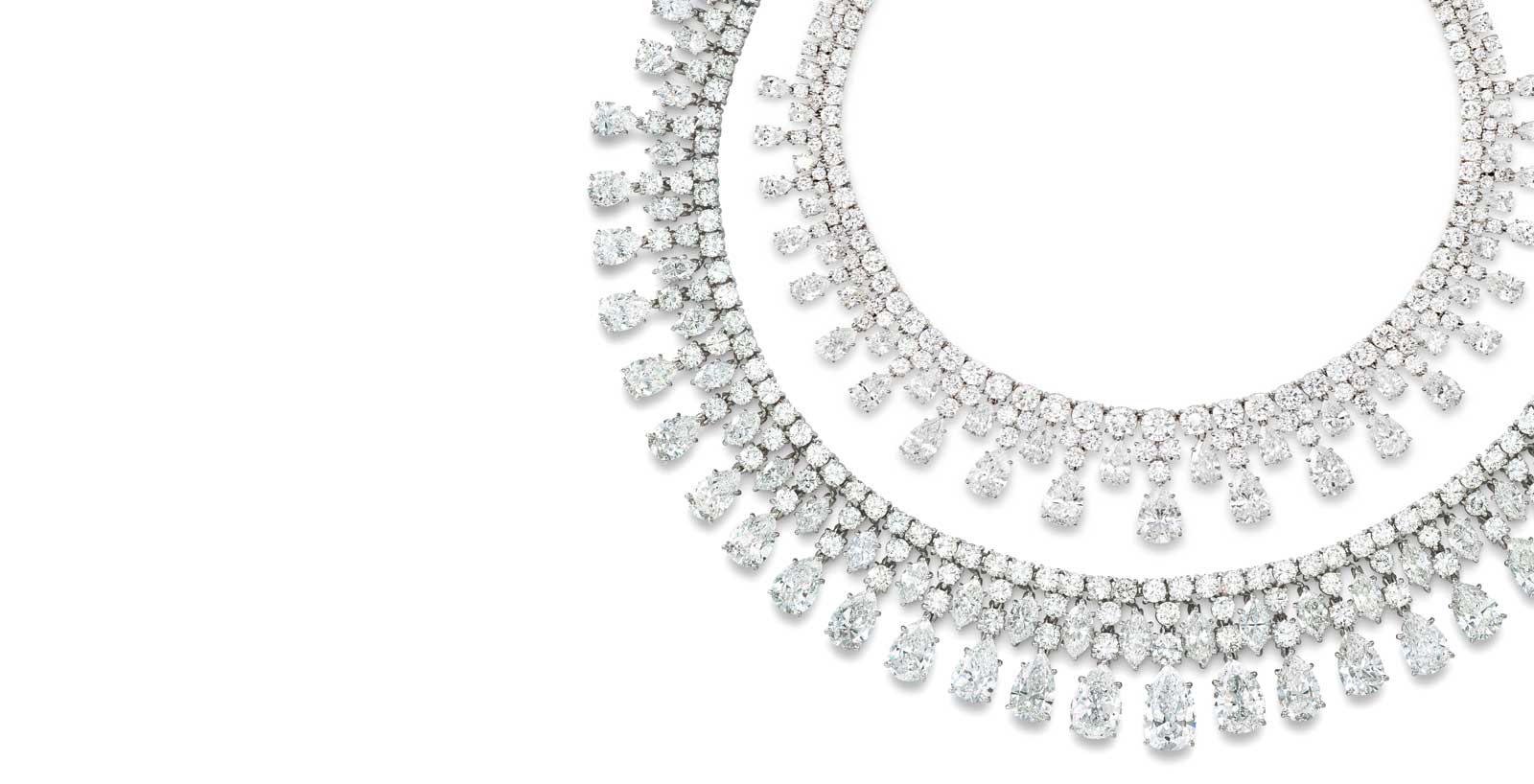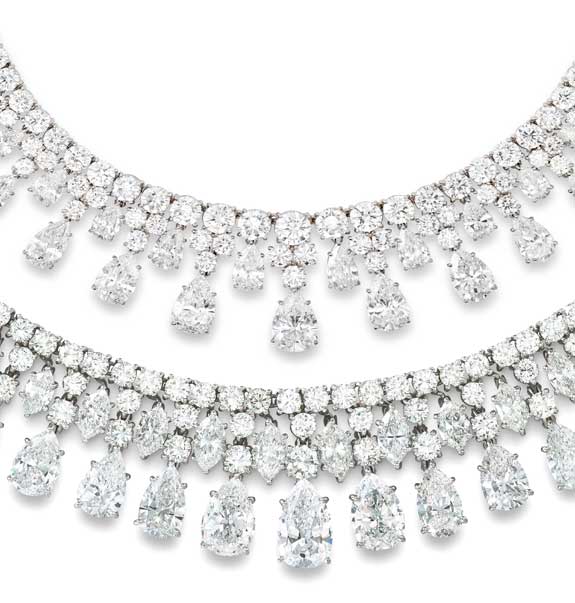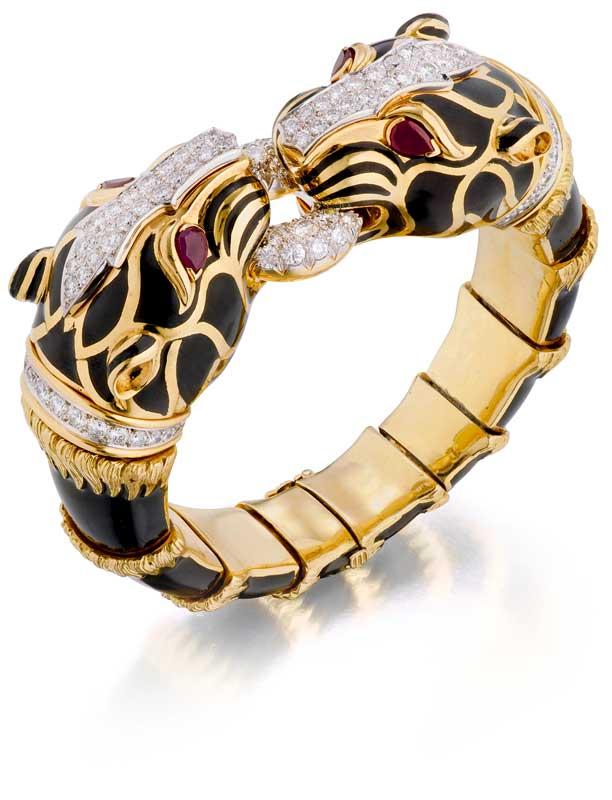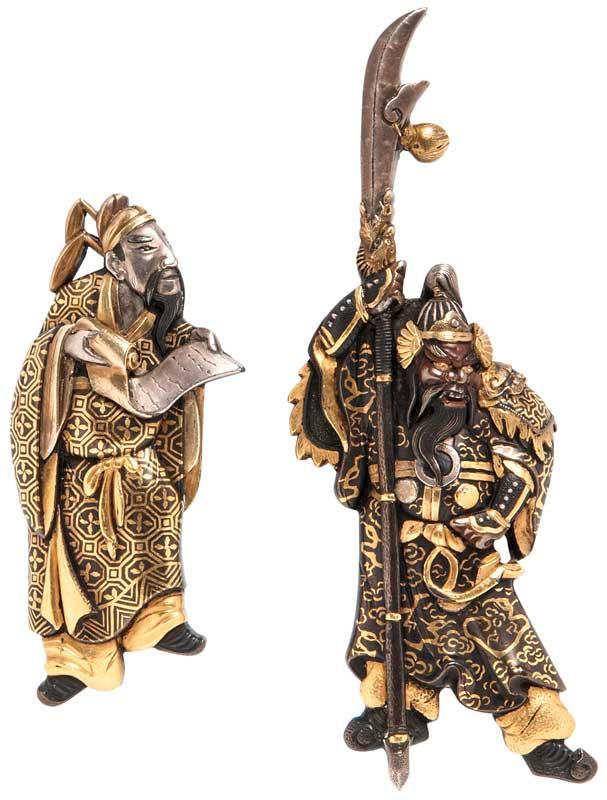
Double-Decker Diamonds
Harry Winston Necklace, Lot #112, $492,500


Double-Decker Diamonds
Harry Winston Necklace, Lot #112 $492,500
Bonhams September sale in New York was built around the 61-lot collection of Katherine Domyan, a two-time gold medal winner for swimming in the 1952 Helsinki Olympic Games. Her jewels ranged from a menagerie of David Webb designs to two significant diamond necklaces by Harry Winston. Virtually every piece was made by a major jewelry company.
Each of the two Harry Winston necklaces shown on the catalog cover is dramatic and eye-catching on its own, but Ms. Domyan liked to wear them together. The necklaces, both made in 1984, are stellar examples of Harry Winston’s style: begin by amassing extremely fine diamonds, well matched in color, cut and shape, and then link them together with the barest minimum of platinum. Only the finest quality diamonds shine in such a simple, unadorned setting. The two necklaces differ mainly in the size of the individual diamonds and the total diamond weight. Lot #111 features three rows of graduating sizes of round diamonds, suspending a fringe of pear-shaped diamonds, further accented by marquise shaped diamonds, with a total diamond weight of 66.20 carats.
Ms. Domyan would wear this necklace nestled above lot #112, which features two rows of graduating round diamonds, suspending a fringe of pear-shaped diamond drops. The total weight of this necklace is 86.30 carats. Many of the pear shapes that comprise the lower level of the necklace would serve as impressive engagement ring center stones, with the largest diamond weighing in at 3.43 carats.
Harry Winston began his business in New York in 1932, in the depths of the Depression. He quickly made a name for himself as the purchaser of some of the largest, and most famous, diamonds then known. He initiated the era of lending jewelry to stars who wore them on the red carpet at awards shows, garnering tremendous audiences for his designs. He had a knack for making headlines, such as when he donated the blue Hope Diamond to the Smithsonian Institution in 1958, giving a major boost to its new gem collection and forever certifying his place as the “King of Diamonds” in the public imagination.

Wild Kingdom
Enamel Bangle, $43,750
Bonhams, New York
September 21, 2018
Bold design, a striking palette, and a signature style distinguish this enamel, diamond and ruby bangle by David Webb, also from the estate of Katherine Domyan. The hinged bracelet depicts two black enamel and gold jaguar heads, each set with ruby eyes and diamond pavé arrow-shaped sections running between its ears. The two heads seem to be tussling with a diamond set circle. Each also sports a diamond-set collar. David Webb’s customers are devoted to his large, dramatic designs, and usually can be counted on to bid up the lots that appear at auction with enthusiasm. This bracelet, estimated to bring $25,000-35,000, sailed over that estimate easily.
Collectors prize the often aggressive designs of his Animal Kingdom collection. The first animal bracelet was made in 1957, not long after Webb arrived in New York from his native Asheville, North Carolina. David Webb customers are often said to need sufficient courage to wear his designs because they make such bold statements. They certainly need a strong sense of personal style to match the distinctive designs.
They are also identifiable across a room, singling out the wearer as a fan of the late designer. Although Webb died in 1975, and his business went through economic ups and downs, it continues to turn out new pieces based entirely on the vast archive of designs he left behind. The meticulous workmanship of his designs is achieved by a small group of highly skilled jewelers who fashion the pieces in the firm’s Madison Avenue showroom and workshop on New York’s Upper East Side, nestled within the neighborhood where many of his customers reside.

High Society
Shakudo brooches, $3,567
Skinner, Boston
September 25, 2018
To hold these two late Edo period shakudo brooches in your hand is akin to embracing history. These two remarkable figures, measuring just 3 ¾ in by 2 /12 inches each, were sold for $3,567. One brooch carries a signature plaque for Hisanori, an historic figure from the Edo era, while the other depicts a scholar. The scholar is sumptuously outfitted in a multi-layered garment, patterned in the shakudo metalwork process, and holds a scroll, denoting his position in society. The samurai figure, with his fierce warrior’s countenance, holds a two-pointed staff. Every aspect of Japanese life during the Edo period, roughly 1615-1868, was codified. Strict social classes were established to create a sense of stability in the country which developed in strict isolation from the Western world.
Japanese craftsmanship during this period developed in ever-more intricate methods, with shakudo being one of the finest examples. The word shakudo derives from the words for red and black, and denotes an alloy of gold and copper, sandwiched into an ingot of layered metals.

Tiny Tilework
Micromosaic Pendant, $3198
Skinner, Boston
September 25, 2018
The archeological revival period in jewelry, peaking in the second half of the 19th century, took inspiration from the important finds being unearthed from ancient ruins throughout Europe. It seemed that everyone wanted to own, or wear, something that evoked the glories of the past. Jewelry embraced this notion in form and style, such as in this fine archeological revival gold and micromosaic pendant. Shaped like an urn, mimicking the real urns found at various sites, the brooch measures just three inches in height. Within that small area are various motifs including a dove and flowers, all exquisitely detailed in tiny bits of glass. Fitted together with supreme skill, the pieces form fully realized images. Only the closest inspection reveals that hundreds of pieces have been used to create the design. The mosaics are then set within elaborate gold frames, embellished with bead and rope work.






















![DEl Kathryn Barton [Australian b. 1972] the more than human love , 2025 Acrylic on French linen 78 3/4 x 137 3/4 inches 200 x 350 cm Framed dimensions: 79 7/8 x 139 inches 203 x 353 cm](/sites/default/files/styles/image_5_column/public/ab15211bartonthe-more-human-lovelg.jpg?itok=wW_Qrve3)



